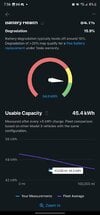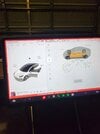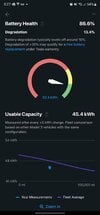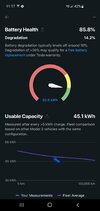Hello all!,
I am a first-time Tesla owner. I would like to know your opinion on my findings.
As I mentioned, I just purchased a certified preowned Model 3 with 40.500 miles through the tesla.com website. I did a good research about Teslas and, among other EVs I considered it the best option.
My experience is mixed. The car looks really good and is in very good shape, also thought I found a very good deal with tesla warranty and the car specs being a Standard Range plus, with 19" wheels and enhanced AP.
My first problem came when we started driving the car. My wife started hearing a weird noise when moving slowly or starting to move. I found out that the lug nuts in the 4 wheels were loose, especially the rear passenger-side one where the noise was coming from. I tightened the lug nuts myself and called Tesla service immediately to check the car in case anything had suffered.
My second problem is that I noticed a really low range in my car after a week of driving and wanted to obtain some guidance. I have downloaded the Tessie app to check and also performed a battery health test in service mode to test against the Tessie app. Here are my findings and some other stats:
-Battery degradation according to Tessie: 15.9%
-Battery health according to health Test on the car: 85% (or 15% degradation)
-Car calculated Range 217mi. (217/250*100 = 86.8% so math kinda checks out)
-Average efficiency according to Tessie app: 75% or 287Wh/mi. This is counting other factors based on my real world use. Which means I get around 162.75mi of real range(0.75*217mi). To my surprise, less range can be driven
-Battery total full load when charged 45.4Kwh. Rated is 54Kwh ( 45.4/54*100 = ~84% Again math maths)
I live in Florida and the weather is really hot during the summer I understand have a big impact in efficiency
I understand I have battery coverage under 100.000 miles if my battery range drops under 70%. But in any case, this seems out of the normal of what I have seen around and by the app and other stats. What can I do to improve my situation based on the information provided? See attached pictures of my health test and Tessie app stats
I am a first-time Tesla owner. I would like to know your opinion on my findings.
As I mentioned, I just purchased a certified preowned Model 3 with 40.500 miles through the tesla.com website. I did a good research about Teslas and, among other EVs I considered it the best option.
My experience is mixed. The car looks really good and is in very good shape, also thought I found a very good deal with tesla warranty and the car specs being a Standard Range plus, with 19" wheels and enhanced AP.
My first problem came when we started driving the car. My wife started hearing a weird noise when moving slowly or starting to move. I found out that the lug nuts in the 4 wheels were loose, especially the rear passenger-side one where the noise was coming from. I tightened the lug nuts myself and called Tesla service immediately to check the car in case anything had suffered.
My second problem is that I noticed a really low range in my car after a week of driving and wanted to obtain some guidance. I have downloaded the Tessie app to check and also performed a battery health test in service mode to test against the Tessie app. Here are my findings and some other stats:
-Battery degradation according to Tessie: 15.9%
-Battery health according to health Test on the car: 85% (or 15% degradation)
-Car calculated Range 217mi. (217/250*100 = 86.8% so math kinda checks out)
-Average efficiency according to Tessie app: 75% or 287Wh/mi. This is counting other factors based on my real world use. Which means I get around 162.75mi of real range(0.75*217mi). To my surprise, less range can be driven
-Battery total full load when charged 45.4Kwh. Rated is 54Kwh ( 45.4/54*100 = ~84% Again math maths)
I live in Florida and the weather is really hot during the summer I understand have a big impact in efficiency
I understand I have battery coverage under 100.000 miles if my battery range drops under 70%. But in any case, this seems out of the normal of what I have seen around and by the app and other stats. What can I do to improve my situation based on the information provided? See attached pictures of my health test and Tessie app stats






